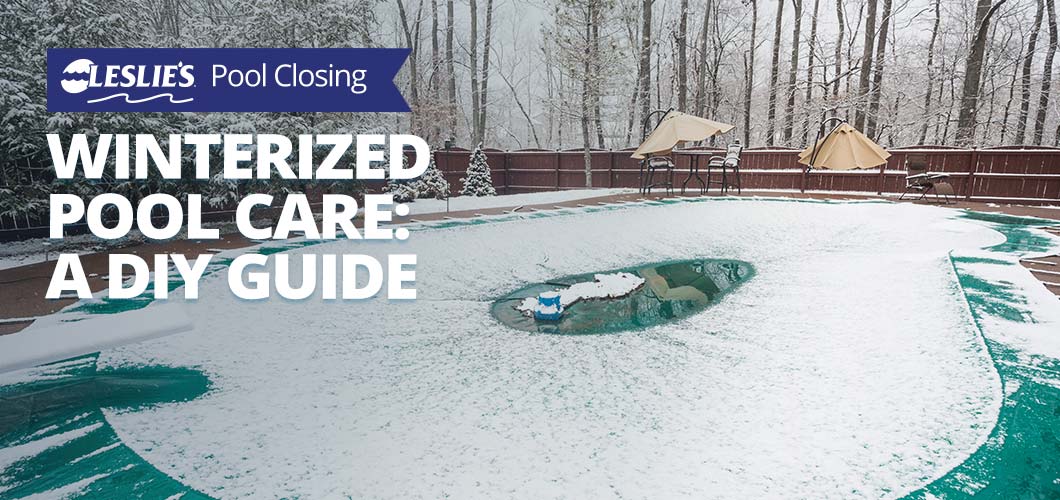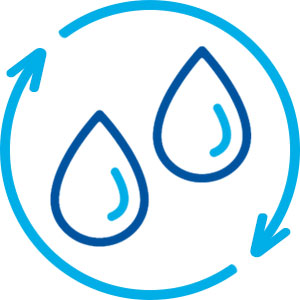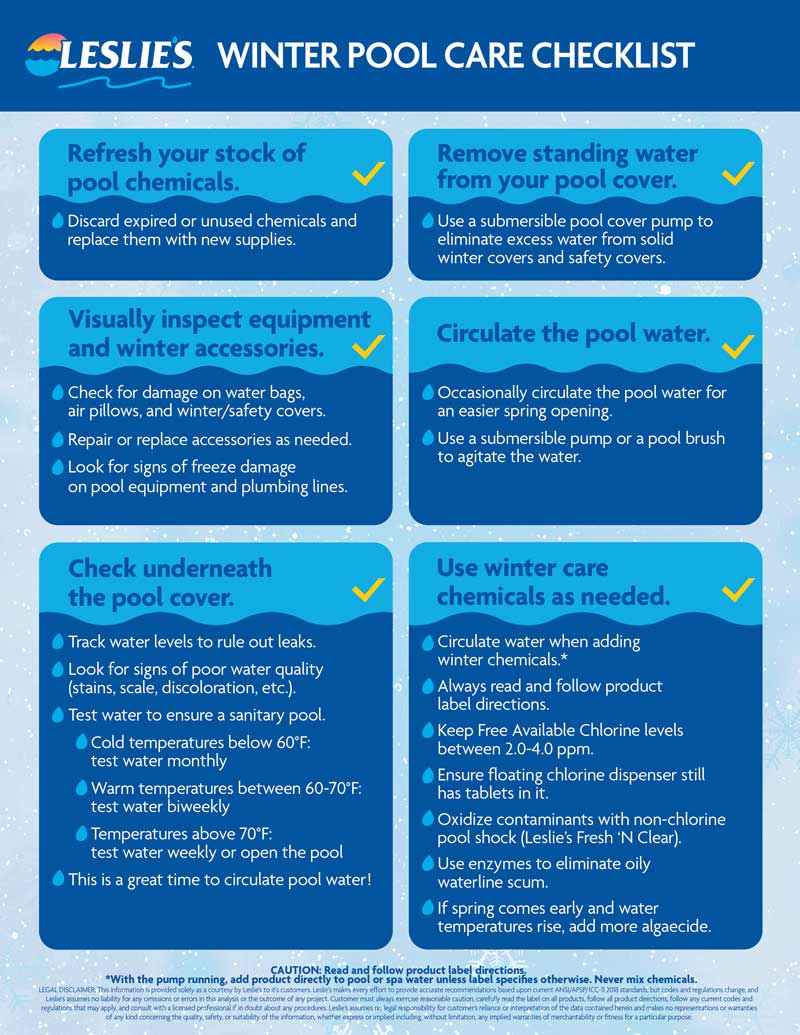
Winterized Pool Care: A DIY Guide
Taking quality care of your pool doesn’t end when the pool closes. Maintaining a pool is a year-round responsibility! At Leslie's, we've helped hundreds of thousands of customers open their pools. And one thing we've learned over the years is that few quick and easy maintenance measures during the winter can make your spring pool opening a breeze. To help you out, we've put those tips together in this handy winterized pool care guide.
Follow these simple tips to maintain your pool water while your pool is closed. Key points include:

Remove excess water from the pool cover with a submersible pump.

Monitor water balance and address signs of stains, scaling, or changes in color.

Circulate pool water to help your sanitizer work efficiently, maintaining fresh, clear water.

Use specialty chemicals as needed to maintain pool water through the off-season.

Visually inspect pool equipment, plumbing, and winter accessories like the pool cover, water bags, and air pillows.
1. Refresh your stock of pool chemicals.
Once the pool's been winterized, one part of your pool care checklist won't even involve the pool at all. While some pool chemicals don’t have an exact expiration date, it’s recommended that you discard all unused pool chemicals from the previous season (with the exception of most dry chlorines). Why? These chemicals lose their potency and will not do the job as well as expected. And of course, pouring an excess of chemicals in the water can be bad for your pool. When disposing of chemicals, refer to the product label for instructions on safe disposal options.
2. Remove standing water and debris from your pool cover.
Excess water on a solid winter cover or safety cover can weigh it down, causing damage or even complete cover failure. And if there are leaves on the cover, standing water will create a dark and murky "tea," which can cause a big mess if it ends up falling into the pool. It's best to remove this extra water with a submersible pool cover pump to protect your pool cover through the winter.
If there is snow or ice present, just leave it be until it melts. We don't recommend attempting to remove it, as this can cause damage to your pool cover.
In addition, try to keep the amount of debris on top of the cover to a minimum. Use a skimmer net or nylon pool brush to remove leaves and other large debris. If you have a lot of leaves in your yard, a leaf net over the top of your winter/safety cover can make it easier to remove the debris quickly.
3. Visually inspect pool equipment and winter accessories.
Check your water bags and air pillows regularly, and refill or replace as needed. Take a good look at your winter cover, looking for signs of damage. If you notice a rip, tear, or worn area, fix the cover with a patch. Or, if the damage is extensive, replace the cover. Even a small hole in the cover can lead to a murky mess in the spring if it's not managed quickly.
While you're at it, visually inspect your equipment and plumbing for any signs of damage, freeze expansion, or other conditions that could compromise opening your pool in the spring.
DIY TIP: If you notice damage to your pool equipment or plumbing, don't panic! There's still time to get it fixed before opening day. However, if you don't notice it until warmer temperatures arrive, we have some tips in another blog post that will help you temporarily maintain a pool with damaged equipment.
4. Circulate the pool water.
When possible, circulate your pool water with a submersible pool pump. Moving the water as much as possible helps your sanitizer work most effectively, leading to a more sanitary pool and an uncomplicated pool opening day. Though not required, it will certainly make a difference if you have a history of troublesome pool openings. Place the pump at one end of the pool, and direct the flow to the opposite end of the pool with a hose.
5. Pull back the corner of your pool cover and check how the water is doing.
As part of your regular care routine on your winterized pool, visually inspect water levels in the pool at least once per month to make sure there's not a leak hiding somewhere. Undetected pool leaks and low water levels can cause lots of problems in the winter, including damage to the pool cover or even the pool itself. If there's a leak, add water to maintain appropriate levels until you're able to locate and repair the leak.
While you're looking under the cover, look at the visual condition of the water. If you notice any changes in color or signs of stains and scale, collect a water sample for testing.
Check your pool chemistry at least once a month (when not frozen) to ensure you have a healthy, sanitized pool. Or, let us do the work for you! Bring your water to your nearest Leslie's, and get your water tested for free. The Leslie's AccuBlue® water testing system provides the most precisely accurate results for 10 different aspects of water chemistry in 60 seconds.
BONUS TIP: With your pool equipment disconnected, you won't be able to circulate the water enough to add most balancing chemicals. When testing your water in the winter, the most important thing is to make sure sanitizer levels are sufficient to combat germs and algae. If other aspects of pool chemistry are way out of balance, the experts at Leslie's can help you figure out the best approach.
6. Keep your pool water fresh with winter care chemicals.
If you need to add pool care chemicals to your winterized pool, it's important to circulate the water in order to disperse the chemicals. As mentioned above, you can do this with a submersible pump and a garden hose positioned at opposite ends of the pool. Using a pool brush to agitate the water is also helpful in circulating the water. If chemicals are allowed to remain concentrated in one area of the pool, it can cause discoloration and damage to pool surfaces.
We don't recommend adding most types of water balancers during the winter. However, when necessary, add chlorine to the pool to keep Free Available Chlorine levels in the 2.0–4.0 ppm range. If using a floating chlorine dispenser, make sure there are still tablets in the dispenser. To help oxidize non-living organic contaminants in the water and make your Free Available Chlorine work more efficiently, add a dose of non-chlorine oxidizing pool shock, such as Leslie's Fresh 'N Clear.
Using an enzyme-based chemical like Natural Chemistry Pool Perfect will also help break down non-living organic contaminants. This greatly reduces the risk of an oily ring of waterline scum appearing, meaning you won’t need to scrub your pool as vigorously come springtime.
During winter, your pool is pretty much dormant, which means that the water is not being circulated. Uncirculated water means microorganisms can grow more easily, because sanitizers like chlorine slowly degrade and disappear. If you know that the off-season will see some warmer temperatures, it’s recommended that you add algaecide in order to protect your pool water. This will help your water make it through to spring startup without an algae bloom.
Bonus Winterized Pool Care Tip
Winterizing your pool is important, but did you know that winterizing your backyard is, too? We’re specifically talking about patio furniture, large outdoor storage spaces, plants, and other outdoor equipment you might own. These items should be securely tied down or moved to avoid movement during strong gusts of wind, which could damage your pool cover if they land on the pool. Keeping your furniture and accessories properly stored or covered will also help protect them through the off-season.
